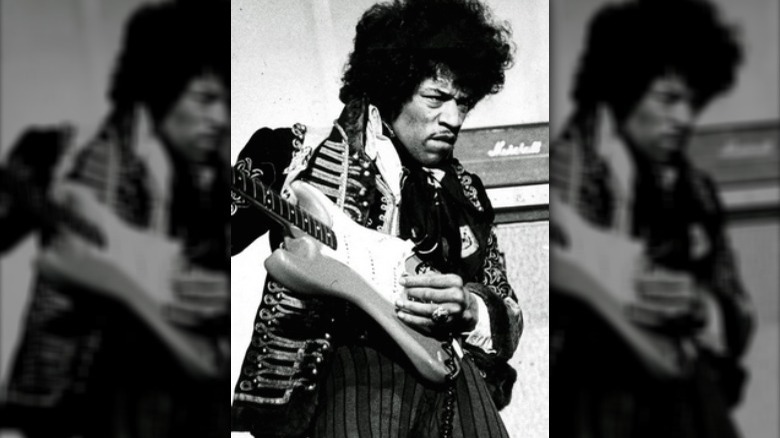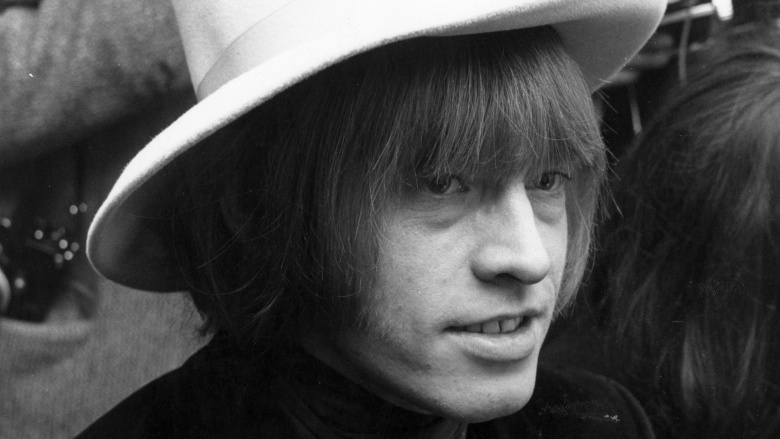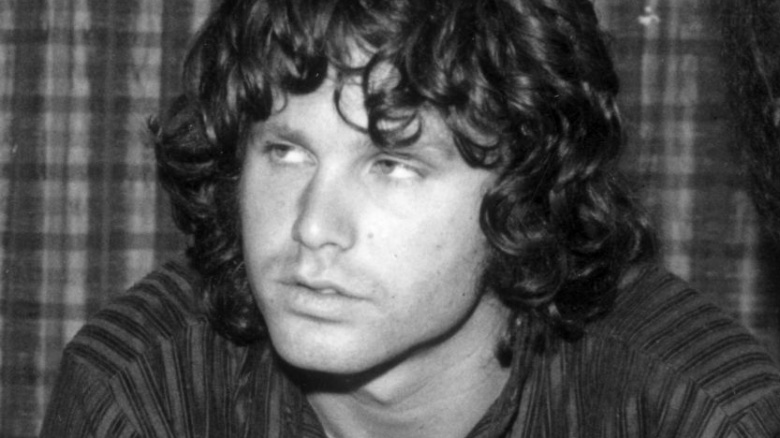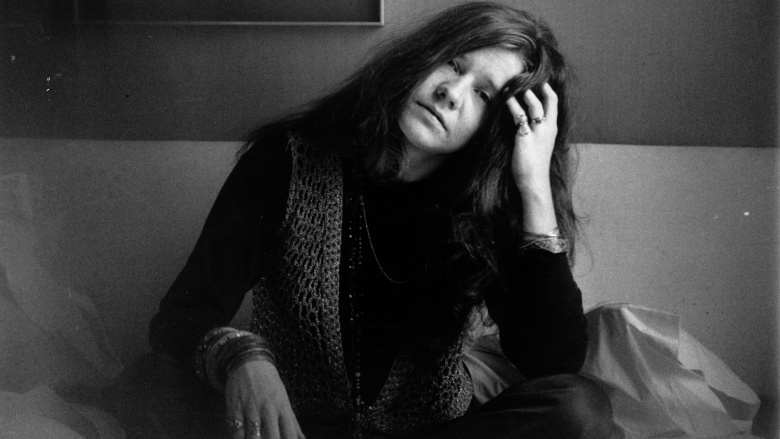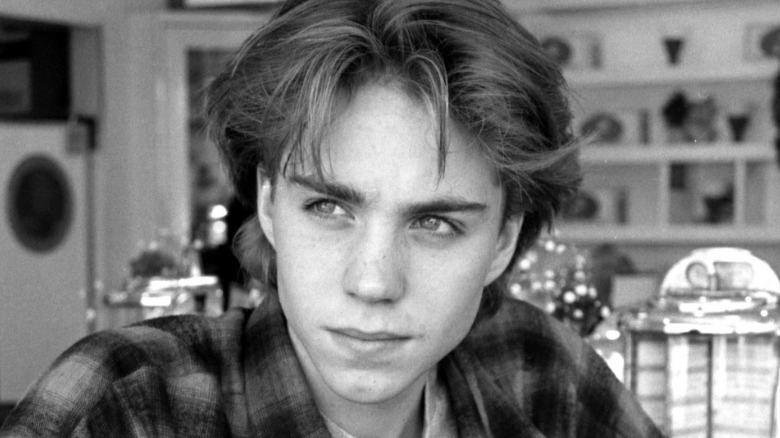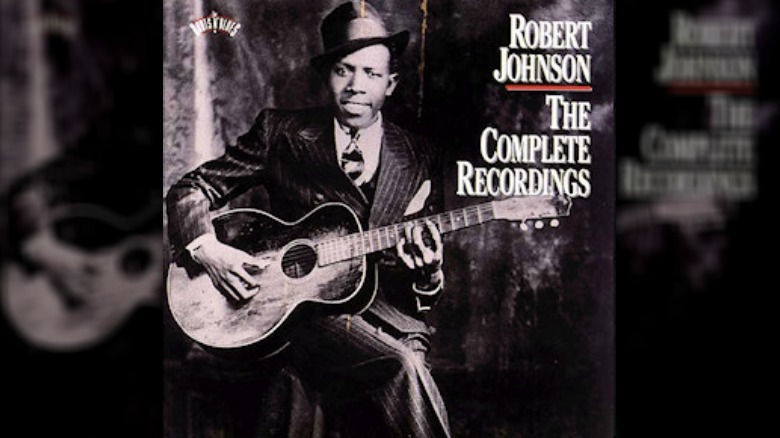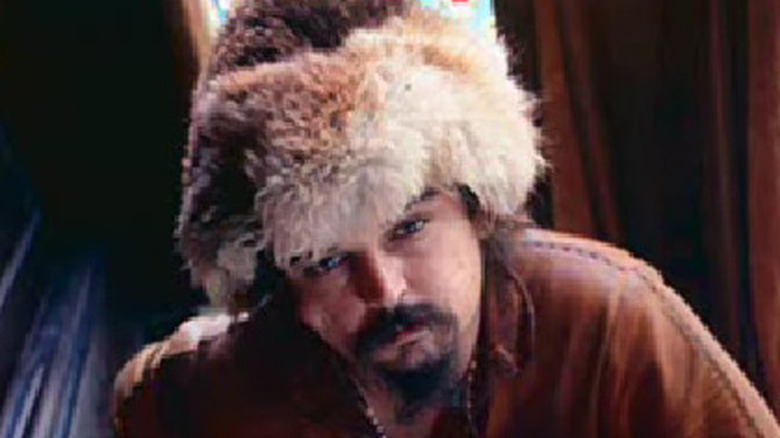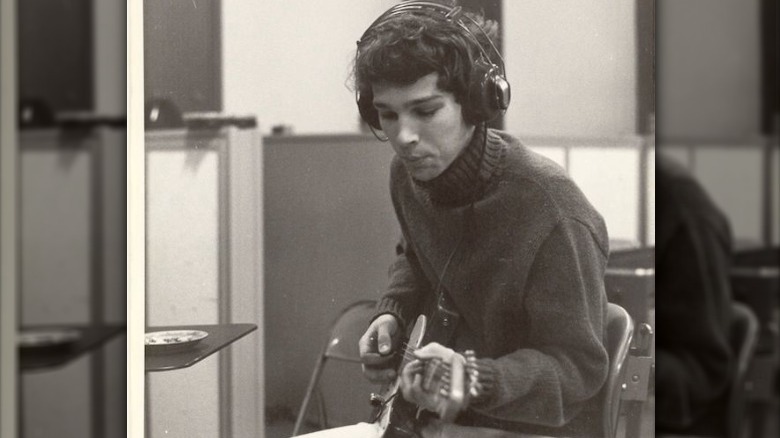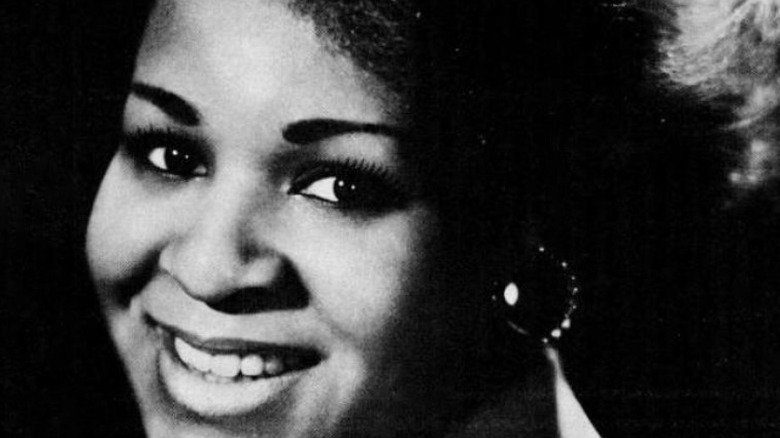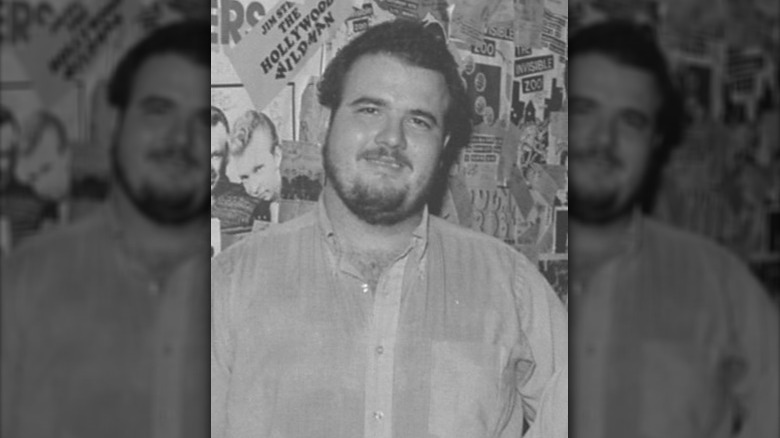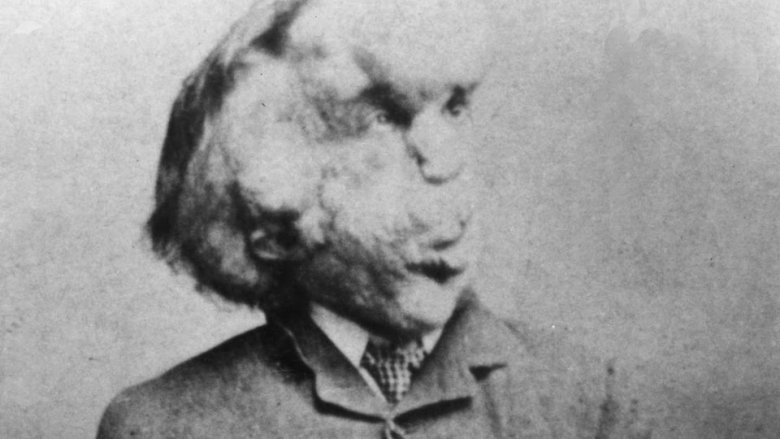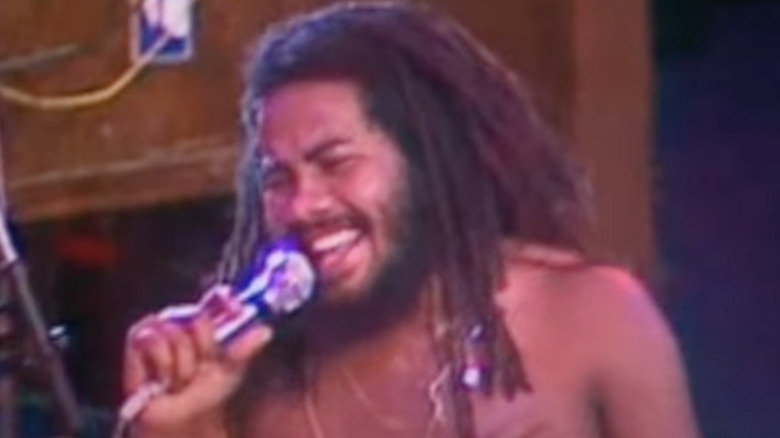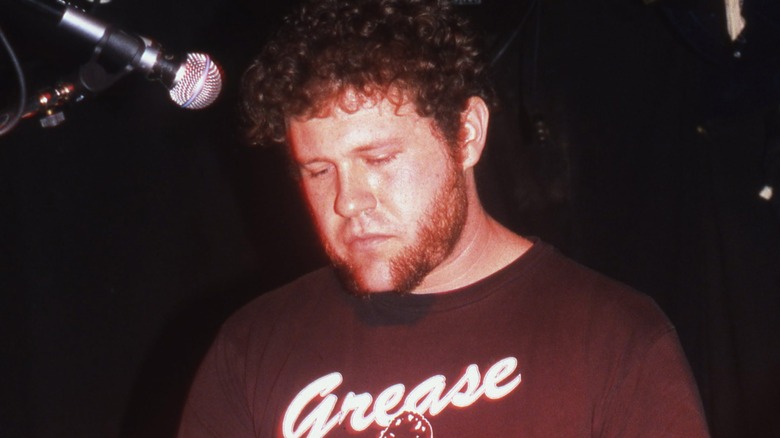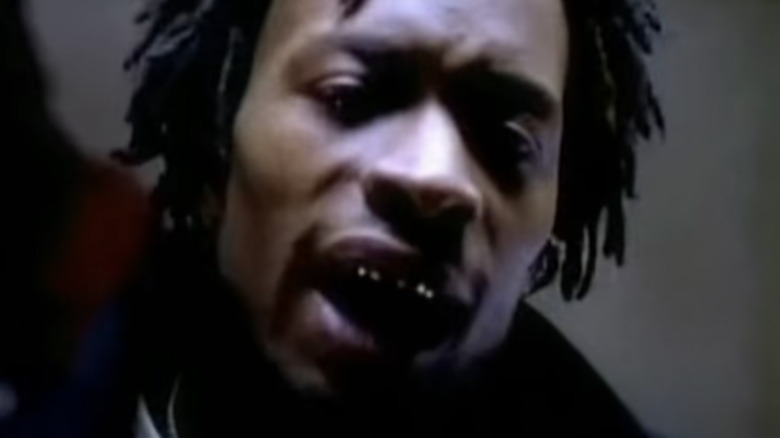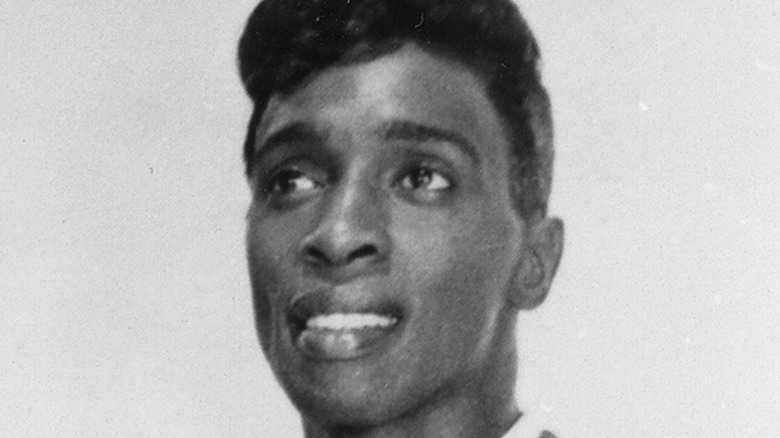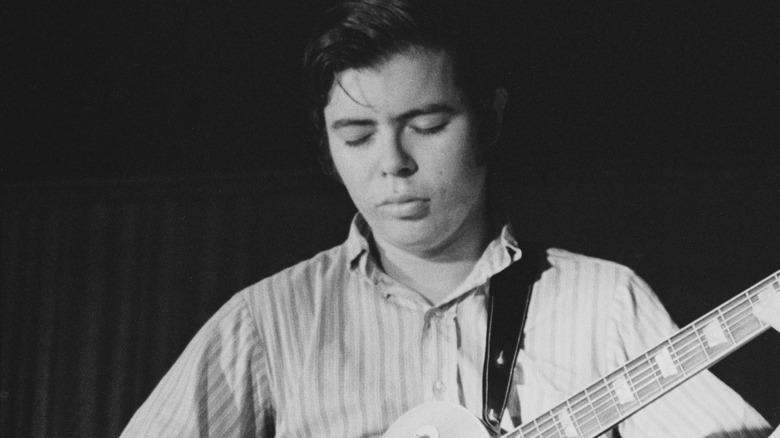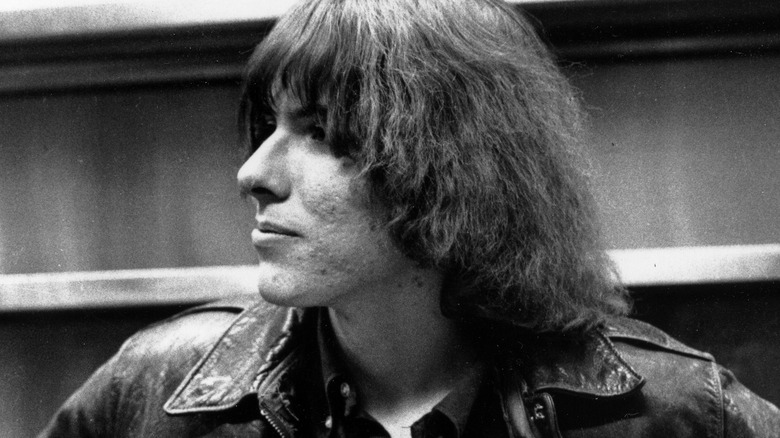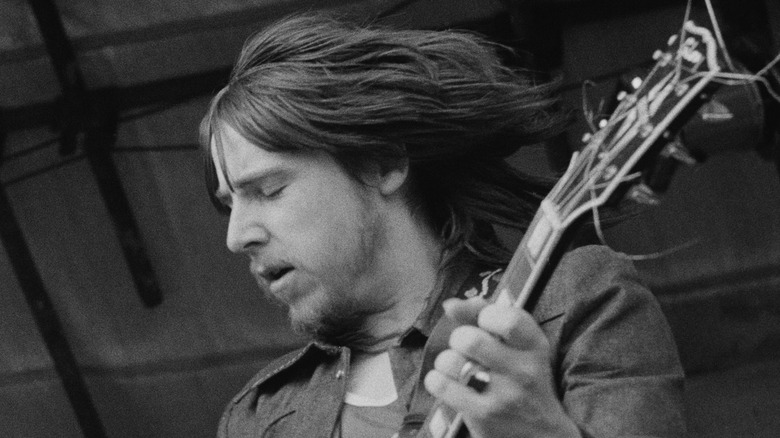The Long List Of Stars Who Died At Age 27
Thirteen gets a bad rap. Sure, it does seem to be less than optimal in the luck department, but if you think 13 is the unluckiest number, you should take a closer look at 27. Once you realize just how many stars and celebrities have died at the age of 27, it starts to get a little distressing, particularly if you happen to be a 26-year-old celebrity. (Yes, it's difficult when your brain is telling you to do stupid things, but stay safe out there, young 'uns.) Life gets really awesome after your 20s, and if you need proof, you can just watch "Friends."
Here are some of the most famous stars who left this mortal coil at the age of 27. Sadly, it's not a short list. Not even close. Let's hope this seemingly cursed number doesn't claim any more famous victims. May long happy lives be lived by all!
If you or anyone you know is having suicidal thoughts, please call the National Suicide Prevention Lifeline at 1-800-273-TALK (8255).
Amy Winehouse
She may have started out jazzy with her 2003 debut album, "Frank," but once she shifted into more soulful territory on 2006's "Back to Black," Amy Winehouse went from being the talk of the U.K. to an international sensation, breaking into the top 10 of Billboard's Hot 100 Singles chart with "Rehab." Although Winehouse's voice was a marvel, and both her look and attitude regularly led to press coverage, she also made more than a few headlines with her intense personal relationships and her tendencies toward excess.
Alas, it was the latter that ultimately led to her downfall — when she died on July 23, 2011, the coroner's inquest (via the BBC) revealed that her blood alcohol level was more than five times the legal limit for driving in the U.K..
Kurt Cobain
Once you've written a song called "I Hate Myself and Want to Die," no one can ever say they were completely blindsided by your suicide. Such is the case with Kurt Cobain, but it would be a disservice to dismiss him as just another rock star with a death wish. His contributions to music would be significant even if "Smells Like Teen Spirit" had been the only arrow in his alt-rock quiver, which it most certainly wasn't.
But Cobain had demons to spare, and although he found solace in writing, recording, and playing music, not to mention his wife (Courtney Love) and daughter (Frances Bean Cobain), they weren't enough to keep those demons at bay. After skipping out of a Los Angeles rehab facility where he was attempting to kick his heroin habit, Cobain flew home to Seattle and turned a shotgun on himself. He died on April 5, 1994 (via History).
Kristen Pfaff
Kristen Pfaff first found regional fame as a member of the Minneapolis band Janitor Joe, but while playing a show with the band in California, Courtney Love and Eric Erlandson tried to sway her into becoming the bassist for Hole. It didn't work then, but she eventually came around. Unfortunately, while in Seattle to record Hole's "Live Through This" album, Pfaff developed a drug habit, one which she had seemingly kicked after temporarily moving back to Minneapolis and entering a detox center in February of 1994, as per the Los Angeles Times.
Clean once more, Pfaff left Hole for a time to rejoin Janitor Joe for a tour — in the wake of Kurt Cobain's death, she made the decision to leave both Hole and Seattle behind for good. Sadly, on June 16, 1994, the day before her reported departure for Minneapolis, Pfaff was found dead in her apartment, after overdosing of heroin.
Jimi Hendrix
Unless you want to accuse the Rock and Roll Hall of Fame of hyperbole, Jimi Hendrix is "arguably the greatest instrumentalist in the history of rock music," which is why his death still causes music fans to contemplate all the amazing music we might have heard had he lived.
Frustrated by, and disillusioned with, the music industry, Hendrix wasn't in the best of psychological states in the final days of his life — as the Independent details, not only was he battling a recording contract dispute, contemplating leaving his manager, and dealing with the departure of bassist Billy Cox from his band, but he'd also been hit with a paternity suit, was having trouble sleeping, and — on top of everything else — was stricken with writer's block. On the morning of September 18, 1970, Hendrix attempted to battle his insomnia by taking nine sleeping tablets, which left him so incapacitated that he choked on his own vomit and died.
Brian Jones
Everyone knows Mick Jagger and Keith Richards, but when they began, the Rolling Stones were initially steered by Brian Jones. As bassist Bill Wyman put it in a 2002 Daily News interview, "He formed the band. He chose the members. He named the band. He chose the music we played. He got us gigs. He was very influential, very important, and then slowly lost it ... and just kind of wasted it and blew it all away."
As the Stones began moving in a more pop-centric direction, Jones grew more frustrated, drowning his sorrows in alcohol and drugs, which led to depression and dramatic mood swings that eventually resulted in his dismissal from the Stones. Although Jones was reportedly in good spirits in his last days, his bad habits did not diminish, and on July 3, 1969, he was found at the bottom of his swimming pool, with the coroner ruling it a case of "death by misadventure," as per Ultimate Classic Rock.
Jim Morrison
"He's Hot, He's Sexy, and He's Dead," was the headline of the September 17, 1981, Rolling Stone cover story about Jim Morrison. Of course, by that point, the lead singer of the Doors had been gone for over a decade, but you never know how long a rock star's legacy will last beyond their death. As it happens, Morrison may be even more popular now than he was then, both because of his music and because his excesses have been richly detailed in a number of books (not to mention Oliver Stone's 1991 biopic, "The Doors.")
As such, it's easy to forget that he's no longer walking among us, but despite rumors that have floated around for the past 45 years, he's definitely gone — on July 3, 1971, Morrison was found dead in his bathtub in his Paris apartment, the cause of death listed as heart failure. The fact that no autopsy was performed has led to theories about how he really died, whether he overdosed accidentally, if he was murdered, or if he even died at all, notes All That's Interesting. He did, of course, but his legacy still looms so large, it's like he never left.
Fredo Santana
Derrick "Fredo Santana" Coleman was a rising star in Chicago hip-hop, thanks to his successful 2013 debut album "Trappin' Ain't Dead," several acclaimed mixtapes, and his hit single "Pass Me My Double Cup." Unfortunately, his success — and life — was short-lived, as he passed away at age 27 on January 19, 2018.
Santana was working to popularize a kind of hip-hop called "drill," which is basically a gritty, angry, nihilistic reboot of trap music. But away from the studio and stage, Santana was battling an all-too-familiar drill theme: drugs. Specifically, Santana was addicted to lean, another term for "purple drank," or cough syrup chugged at dangerously high levels. This caused him to suffer some major heart and kidney issues, something he publicly displayed just months before his death. On October 12, 2017, he posted a video to his Instagram saying he was in the hospital due to kidney and liver failure. As he wrote, "I wouldn't wish this on my worse [sic] enemy." Three months later he was deceased, although his official cause of death was attributed to epilepsy, reports the Chicago Tribune.
After his death, condolences came from across social media. Rapper Drake posted a picture of the two on Instagram and simply wrote "Rest in Peace Santana," while Against The Odds Management tweeted that it was "sad to see a young boss go at an early age." Meanwhile, rapper Chief Keef tweeted to everyone calling Santana his friend: "That's my cousin, Big difference." It's bad enough to lose a friend. Keef lost family.
Janis Joplin
Inspired by beautifully bluesy ladies like Billie Holiday, Ma Rainey, Bessie Smith, and Big Mama Thornton, Janis Joplin quickly developed a reputation in the rock community for being able to furiously belt out numbers just as well as any man. As Vogue's Richard Goldstein wrote of her, "She slinks like tar, scowls like war ... Clutching the knees of a final stanza, begging it not to leave ... Janis Joplin can sing the chic off any listener." But she could also hold her own against men when it came to drinking and drugging, and therein lay the problem.
Although she blew audiences' minds at the Monterey Pop Festival, Woodstock, and on the legendary Festival Express train tour through Canada, Joplin's heroin habit was profound, and her alcohol intake was just as bad. Although efforts were made to sway her into rehab, she finally succumbed to her addictions on October 4, 1970, dying of a heroin overdose (via History).
Anton Yelchin
One of the most tragic in recent memory, Anton Yelchin earned his membership in the 27 club in what has repeatedly — and rightfully — been described as a freak accident.
As CNN reports, on June 19, 2016, Yelchin, known to millions of moviegoers worldwide for his work as Pavel Chekov in J.J. Abrams' "Star Trek" series, got out of his Jeep Cherokee while in the driveway of his house in Studio City, California. Then, the car rolled back, pinning him against a brick pillar and a security fence. By the time friends found Yelchin, he was dead, with the Los Angeles County coroner's office declaring his death to have been the result of blunt traumatic asphyxia. When "Star Trek Beyond" hit theaters a few weeks later, it was dedicated to Yelchin's memory.
Chance Perdomo
Chance Perdomo was born in 1996 in Los Angeles, but did the bulk of his growing up in the UK, which is where he found his calling in theater, and eventually, television and film. His first well-known role was Ambrose Spellman in "Chilling Adventures of Sabrina," but more recently he enjoyed playing a new character (and growing fame) as Andre Anderson in a "The Boys" spinoff called "Gen V."
Sadly, on March 29, 2024, Perdomo's life was cut short as the actor was killed in a motorcycle accident. His publicist released a statement to Variety: "It is with heavy hearts that we share the news of Chance Perdomo's untimely passing as a result of a motorcycle accident. Authorities have advised that no other individuals were involved. His passion for the arts and insatiable appetite for life was felt by all who knew him, and his warmth will carry on in those who he loved dearest. We ask to please respect the family's wish for privacy as they mourn the loss of their beloved son and brother."
Jonathan Brandis
Although already a soap opera actor while he was still in single digits — securing the role of Kevin Buchanan on "One Life to Live" when he was all of 6 years old, it was as a teen heartthrob that Jonathan Brandis found the greatest success of his career, courtesy of the NBC series "SeaQuest DSV" and films like "The NeverEnding Story II," "Sidekicks," "Ladybugs," and Stephen King's "It."
When "SeaQuest" wrapped its run in 1996, however, things began to slow down for Brandis. Although he secured roles in "Outside Providence" and "Ride with the Devil," his role in the 2002 Bruce Willis film "Hart's War" was virtually trimmed out of existence in the film's final cut, and his 2003 pilot "111 Gramercy Park" failed to be picked up. Whether it was because of these turns of events, or for utterly unrelated reasons, Brandis hanged himself on November 12, 2003, as per CBS.
Jean-Michel Basquiat
If you had even a passing interest in New York's neo-expressionist art scene in the 1980s, then you couldn't help but be aware of Jean-Michel Basquiat, whose work impressed no less an authority than Andy Warhol and ultimately led to both a friendship and a period of creative collaboration between the two artists. Oh, and did we mention that he dated Madonna for a while, too? Plus, he was in the video for Blondie's "Rapture" (via Far Out Magazine), which is an impressive claim to fame in and of itself.
On the infamy side of things, however, he had an addiction to heroin, and when Warhol died in February 1987, Basquiat sank into both depression and drugs. He ultimately overdosed on heroin on August 12, 1988 (via Biography).
Robert Johnson
If you're into the blues, classic rock, or just music in general, you owe a debt to Robert Johnson. The man defined Chicago and delta blues, despite only recording a handful of tunes. But when those tunes include "Sweet Home Chicago," "Crossroad," and "Love In Vain," you've already written more than enough to ensure your artistic immortality.
Unfortunately, his physical mortality didn't last long. Johnson's death, like Johnson himself, is shrouded in mystery and rumor. This is the guy, after all, who claimed he sold his soul to Satan at a Mississippi crossroads in exchange for mastery of the guitar. There's no 100% confirmation of how he died on August 16, 1938, only that he did. According to Mother Jones, some say he died of syphilis, some say he had a tissue disorder called Marfan syndrome, others insist he was poisoned by the jealous boyfriend of a woman he was wooing, and still others say Johnson's own girlfriend poisoned him.
The only person left alive who knew Johnson, a bluesman named David Honeyboy Edwards, claims that he witnessed Johnson's murder, and that it was indeed a man angered that Johnson was flirting with his girlfriend. If true, this jealous guy poisoned Johnson's whiskey, and a few days after drinking it, the man was dead. He did not have possession over Judgment Day after all.
Ron 'Pigpen' McKernan
Ron McKernan was one of the founding members of the Grateful Dead, a singer, organist, and harmonica player who worked hard to establish the band as a pioneer in jug- and blues-based rock. Unfortunately for him, the band didn't share that vision for very long. The group got heavily into LSD and began recording more psychedelic music, leaving "Pigpen," a hard-drinking blues guy who didn't care for trippy drugs, out in the cold.
By 1970, McKernan's drinking had begun to really affect him, notes Ultimate Classic Rock. It was hurting him so much, he had to quit touring. He couldn't stay away for long, though, and was back the next year. By June 1972, however, he was completely done with both touring and the band. He simply couldn't operate anymore, and on March 8, 1973, he suffered an internal hemorrhage and died. He didn't last long with the Grateful Dead, but the band never would've taken off without him.
Pete Ham
Pete Ham of Badfinger is a tragic example of the business side of the music industry completely destroying the creative side and taking lives with it. The band itself was poised to be the next Beatles, even getting signed to the Beatles' label, Apple Records. Ham was the smiling face of the band, a fine guitarist who had limitless potential. But then, the very business that was poised to make him huge completely betrayed him.
As detailed in "Suicide in the Entertainment Industry," by David K. Frasier, the band found financial representation in New York businessman Stan Polley, who netted them a six-figure contract with Warner Records in 1974, but would only give them a grand a month in allowance. The rest, he claimed, was being saved and invested. In reality, it was being stolen — Warner sued the band after realizing $600,000 in advances were missing. Basically, Polley and others had cashed in Badfinger's checks for themselves. This destroyed the band, and especially Ham. Financially broke, emotionally broken, and with a child on the way, Ham was desperate. On April 23, 1975, Ham and bandmate Tom Evans met to discuss what to do. After drinking 10 scotches, Ham told Evans, "Don't worry, I know a way out." That way out was permanent, as he went home and hanged himself early the next morning. Eight and a half years later, still devastated by his friend's suicide and still fighting for money he earned years ago, Evans drank heavily and hanged himself, too.
If you or anyone you know is having suicidal thoughts, please call the National Suicide Prevention Lifeline at 1-800-273-TALK (8255).
Chris Bell
Chris Bell of '70s power pop group Big Star (the band who wrote the theme song for "That '70s Show") wasn't a big name. He was hardly a name at all, even though he absolutely should've been, which makes his untimely death even sadder.
Bell was the singer, songwriter, and head mixer for most Big Star songs. But it was fellow Star Alex Chilton, already famous thanks to his stint in the Box Tops, who got the attention. This despite Bell absolutely being the leader of the band, even (according to Vice) directing Chilton in the studio's mic booth at times. It was perhaps this feeling of not getting credit where it was due, plus Big Star's debut album not selling as well as he'd hoped (along with latent mental issues) that prompted Bell to leave the band after one album. Unable to find a record deal, he wound up working at his father's hamburger restaurant while recording solo material, which can't have helped his depressed, frustrated psyche any.
On December 27, 1978, Bell was found dead after a car crash. He had lost control of his car and it slammed into a wooden pole, which landed on him and killed him on the spot. It was ruled an accidental death.
Linda Jones
Had Linda Jones lived longer, she might have become one of the most famous gospel-tinged soul singers of all time. In 1967, Jones hit the big time with her song "Hypnotized"; she was on her way to becoming a star along the lines of Cissy Houston and Dionne Warwick, only fiercer. As Hampton Roads pointed out, Jones didn't let up on the fiery drama in her voice even when threatening to cross over into the pop scene. She would still wail, and her voice would still sometimes get distorted on the microphone, such was her power. Would she have stayed that pure in the decades to come? We don't know because she didn't complete her third decade.
Jones, a diabetic, was at her mom's house on March 14, 1972, following an afternoon show at the Apollo in Harlem. She asked her mom to wake her up from a nap in time for her evening show. When her mom went to do that, she found Jones unconscious. Her mother called for an ambulance, but she was already gone, the victim of a diabetic coma. It's not the most soulful way to go, but a sadly realistic one.
D. Boon
The Minutemen are among the most beloved hardcore punk bands of the '80s, and their guitarist, D. Boon, was a huge reason why. (The "D" stood for Dennes, so you can see why he'd prefer just an initial.) An innovative guitar player who fused hardcore ferocity with folk, funk, and classic rock influences, D. Boon sounded like nobody else. He didn't write like anyone else, either, crafting inflammatory yet amusing tunes like "Bob Dylan Wrote Propaganda Songs," "Do You Want New Wave or Do You Want the Truth?," and "Political Song For Michael Jackson To Sing." Boon was clearly having fun doing what he did.
It's a shame, then, that it ended so quickly. On December 22, 1985, Rolling Stone reports, Boon was riding in a van in Arizona when it crashed and killed him. His death also brought an end to the Minutemen, long before their time should have been up.
Pete de Freitas
English rock band Echo and the Bunnymen have been active and successful since the late 1970s, though drummer Pete de Freitas sadly only lived to see part of it. He joined in 1980 and played on the band's first five albums. According to the band's manager, Bill Drummond, he was originally seen as "the sanest and most balanced of the Bunnymen." But according to Mojo 4 Music, drugs and manic episodes took their toll on Freitas, and he actually left the band in 1986. He returned the next year to record a new album, and this time he was married; a child came the following year. It looked like Freitas was back to being the sane one.
Tragically, this new phase of his life didn't last long. On June 14, 1989, Freitas was riding his motorcycle from Liverpool to London when he collided with a car and died. Echo and the Bunnymen continued without him, though with a far darker air than before.
Mia Zapata
Mia Zapata joined the 27 Club not because of drugs or an accident or suicide like many others. She joined because a psychopathic rapist decided it was the night to strike.
Zapata was the lead singer for Seattle grunge-punk band The Gits, who were starting to come into their own during the Age of Nirvana. But then, catastrophe struck — on July 7, 1993, after leaving a bar, Zapata was attacked by a man named Jesus Mezquia. He beat her, raped her, and then strangled her to death with the cord of her sweatshirt, reports Rolling Stone. He then proceeded to evade capture for over a decade until DNA on Zapata's body linked Mezquia to her murder (via Pitchfork). He was sentenced to 37 years in prison in 2004, though his sentence was overturned a year later. Oddly enough, Mezquia asked to be re-sentenced to the original 37 years in 2009, a request the judge granted. No one knows why, but no one's really complaining either.
Creepily enough, a song that Zapata wrote for the Gits' second album, released after her death, all but foretold what would happen. Her song "Sign of the Crab" is about being murdered by a complete stranger, including lines like "Go ahead and slice me up / Cause you know you're the one that won't be found." Not at all the kind of thing anyone wanted to come true.
Joseph 'Elephant Man' Merrick
Joseph Merrick wasn't exactly an entertainer by choice. He suffered from extreme deformities almost his entire life, though to this day nobody knows what he had. According to the BBC, some believe he had Proteus syndrome — a rare condition where bones and tissue overgrow — or possibly neurofibromatosis, where tumors grow around the nervous system. But since his bones have been bleached over the years, analyzing his DNA has thus far proven difficult.
Merrick was unable to find steady work or legitimate human affection — people simply found him too grotesque. He wound up in a British workhouse system, until he realized his curse was the only way he could ever make a legitimate income. And so, he joined the freak show circuit as "The Elephant Man," charging people to gawk at his enlarged head, protruding trunk-like forehead growth, and overgrown right arm. This lasted until England got disgusted enough to outlaw his act, and he moved to Belgium. They too were disgusted, plus Merrick's manager basically stole his money and sent him back to England, destitute. At that point, Merrick had little choice but to remain in a hospital for the rest of his days.
On April 11, 1890, those days ended; Merrick died in his sleep. Due to the extreme weight of his head, he was unable to sleep lying down, and instead snoozed while sitting up. That night, however, he attempted to, as his friend Frederick Treves put it, "be like other people," and crushed his own windpipe as a result.
Jonghyun
Kim Jong-hyun — simply Jonghyun to his fans — was a South Korean music superstar. The singer for pop band Shinee had been scoring as a solo artist, with his 2016 album She Is topping the Gaon music charts and reaching No. 4 on the Billboard World charts. He had another album in the works (posthumously released in January 2018), and was becoming South Korea's answer to Bieber and Zayn. That all changed on December 18, 2017, when he was found dead in his Seoul apartment.
By all accounts, it was a suicide. According to Page Six, Jonghyun had been texting his sister with messages like "I've had a hard time. Please let me go and say that I did a good job. This is my last word," which alarmed her enough to call authorities. By the time they arrived, he was already unconscious, the victim of carbon monoxide poisoning from heated charcoal (as per local news sources).
According to the Washington Post, he suffered from depression, often publicly discussing it and the effect fame had on him. As he detailed in his suicide note, which was posted to Instagram by friend and fellow pop star Jang Hee-yeon, "The life of fame was not for me ... Why did I choose this life? ... It's a miracle that I lasted this long." He also added, "I'm broken from the inside ... the depression that has slowly eaten away at me has finally consumed me, and I couldn't beat it."
Harry Hains
Harry Hains was a talented young performer just starting to break into the public consciousness, through his appearances on popular TV shows like "American Horror Story," "The Deleted," and "The OA." His most significant roles proved to be in independent films such as "The Surface" (2015), where he portrayed a young man, raised in foster homes, searching for a sense of family: a reviewer on Eye for Film credited the youthful actor with skillfully enabling viewers to identify and empathize with his distanced, disaffected character. Towards the end of 2019, according to the Los Angeles Times, the 27-year-old actor was working on a horror movie titled "Klowns," and the miniseries "Xtra Life."
Behind the scenes, unfortunately, Hains was also struggling with addiction and mental illness. On January 10th, his mother Jane Badler, herself a performer in the 2009 science fiction series V, shared on her Instagram that her son had died a few days prior, writing that, "A brilliant spark shone bright too short a time ... I will miss you Harry every day of my life." In a comment on her post, famed actor John Stamos shared his condolences, and credited Hains' "sense of humor and kindness" for getting him through a dark time in his own life. Due to the nature of the actor's personal struggles, it has been speculated that he committed suicide, though the official cause of death has not been released.
If you or anyone you know is having suicidal thoughts, please call the National Suicide Prevention Lifeline at 1-800-273-TALK (8255).
Thomas Fekete
The Florida-based power pop band Surfer Blood formed in 2009, according to Billboard, and quickly caught on with indie rock fans with its 2010s albums "Astro Coast," "Pythons," and "1000 Palms." Those records, and hit singles like "Swim" and "Floating Vibes," were driven by the bright, clipped, surf guitar-inspired, '90s throwback-style instrumental work of Thomas Fekete, who also released a single cassette-only album under his own name following years of prolific touring and recording with Surfer Blood.
According to a GoFundMe fundraising page setup by the guitarist (via Pitchfork), Fekete underwent surgery in 2015 to remove a large abdominal tumor, a sign of a rare and particularly aggressive form of cancer, which soon spread to the musician's spine and lungs. Slightly more than a year later, Fekete's wife shared with GoFundMe followers (via Pitchfork) that the Surfer Blood guitarist had died from cancer complications at the age of 27.
Jacob Miller
Inner Circle is among a rare handful of Jamaican reggae acts to find blockbuster success in the U.S., which they achieved with a couple of smash hit singles in the early 1990s: "Sweat" and "Bad Boys," the latter better known as the catchy theme song to the reality TV show "Cops." More than a decade earlier, according to Reggaeville, the group was a sensation in the U.K. and France, where they ran up the charts with "Mary, Mary" and "Music Machine." Inner Circle embarked on a U.S. tour in the late '70s, one of the first Jamaican groups to ever do that. And it was all built on the sweetly sung vocals and magnetic stage presence of Inner Circle's original lead singer, Jacob Miller.
In March 1980 (via the Jamaica Observer), just after a trip to Brazil with friend and fellow reggae icon Bob Marley to open a branch of their label, Island records, in Brazil. As per Dancehall Mag, Miller was driving in Kingston, Jamaica. The 27-year-old musician reportedly dropped a piece of sugarcane he was chewing on, reached down to pick it up, and crashed his car into a wall.
Jeremy Ward
As Rolling Stone details, after splitting up their alternative metal band At the Drive-In just after the release of the 2000 commercial and critical breakthrough "Relationship of Command" (via Kerrang) singer Cedric Bixler-Zavala and guitarist Omar Rodriguez-Lopez formed a new group, the heavy psychedelic and experimental rock act the Mars Volta, bringing in from their dubstep side project De Facto musician Jeremy Ward. Officially listed as a "sound manipulator," per Rolling Stone, Ward added layers of effects and vocals to the band's guitar-based sound.
According to Billboard, Mars Volta had stopped into Los Angeles in May 2003 for a week-long respite between segments of a tour as the opening act for the Red Hot Chili Peppers, with its debut album set for release in June. Ward wouldn't live to see it. The keyboardist and sound manipulator died on May 25, 2003, of a drug overdose, per record label Gold Standard Labs. Ward was 27.
Freaky Tah
The Lost Boyz is a hip-hop crew formed in 1993 by South Jamaica, Queens, New York friends Pretty Lou, Spigg Nice, Mr. Cheeks, and Freaky Tah, who started making music together as teenagers, according to AllMusic. The group scored some energetic, visceral hits, like "Lifestyles of the Rich and Shameless, "Get Up," "Music Makes Me High," and particularly "Renee," an R&B/hip hop hybrid that heavily features Freaky Tah.
As he exited a party at the Four Points Sheraton Hotel in Queens, New York, just before 4 a.m. on March 28, 1999, Freaky Tah (real name: Raymond Rodgers) was shot in the head by an assailant wearing a ski mask, per the New York Times. The rapper was rushed to Jamaica Hospital Medical Center and died half an hour after arrival. According to MTV News, Kelvin Jones pleaded guilty to a charge of murdering the 27-year-old rapper. According to The Source, Freaky Tah was the victim of mistaken identity — his murder was an act of retaliation for another killing, one which he wasn't remotely culpable.
Rudy Lewis
The Drifters, an inductee into the Rock and Roll Hall of Fame, were one of the premiere vocal soul groups of the 1960s, first serving as backup to R&B star Clyde McPhatter. Among their pop classics and oldies radio standards: "Save the Last Dance for Me," "This Magic Moment," "There Goes My Baby," "Up on the Roof," and "On Broadway," the latter two with lead vocals performed by Rudy Lewis.
According to "The Encyclopedia of Dead Rock Stars," the Drifters had a difficult time replacing breakout star Ben E. King, who left the group in search of a solo career. Johnny Williams and James Poindexter left over personal and professional reasons while Lewis exited the band by way of his death. In May 1964, Lewis was discovered dead in a hotel room with a needle in his arm, one of several indications that he overdosed on heroin at the age of 27.
Alan Wilson
One of the most promising rock bands of the late 1960s, Canned Heat were purveyors of a gritty, party-worthy "boogie-rock" sound, according to Loudersound, combining pronounced elements of the blues with the sounds of the emerging genres of heavy metal and psychedelic rock. Musically directed by frontman Alan "Blind Owl" Wilson, Canned Heat played two of the most important festivals of the era, Woodstock and the Monterey Pop Festival, and scored big hits and classic rock radio staples like "On the Road Again" and "Going Up the Country."
In September 1970, the 27-year-old singer, guitarist, and harmonica player was discovered dead in a sleeping bag on the property behind a friend's home in Los Angeles' Topanga Canyon, according to UPI (via the New York Times). Sleeping pills were found in Wilson's possession, and a representative of Canned Heat's label, Liberty Records, reported that the musician had suffered from depression. Per Ultimate Classic Rock, the cause of death was later determined to be a barbiturate overdose, although it was never conclusively proven that Wilson had done so intentionally.
Dave Alexander
Barreling loudly and chaotically out of Detroit in the 1960s, the Stooges brought big energy, a sense of danger, and rapidly played, feedback-heavy guitar riffs to rock. According to Pitchfork, the Stooges were a seminal porto-punk act, inspiring the genre that would revolutionize rock in the 1970s and early 1980s. Along with the wild stage antics and theatrical vocals of singer Iggy Pop, the thunderous bass playing of Dave Alexander factors heavily in the Stooges' early work, particularly on its acclaimed breakthrough second album, 1970's "Fun House," after which he was fired from the band (via Loudwire).
According to "The Encyclopedia of Dead Rock Stars," Alexander's voluminous use of serious drugs led him to forget how to play the band's songs during a 1970 set at the Jackson Goose Lake Festival. And for that, Iggy Pop fired Alexander and replaced him with Ron Asheton. Alexander reportedly kept using drugs, and his health declined until he developed pneumonia and died in February 1975 at age 27.
Les Harvey
Stone the Crows emerged from the Scottish pub-rock scene in the early 1970s, according to AllMusic. And they looked to be competitors with the likes of similar blues-heavy bands from the U.K. popular at the time, such as Led Zeppelin, whose manager, Peter Grant, produced some Stone the Crows records. The band's sound was built on the interplay between the howling vocals of singer Maggie Bell and agile guitarist Les Harvey.
The band's original, prime lineup would last just about three years owing to a tragic, public death of one of its members. On May 3, 1972, according to "The Encyclopedia of Dead Rock Stars," Harvey was tuning his guitar on stage at a concert in Swansea, Wales. With around 1,200 fans bearing witness, Harvey innocently reached out for a microphone, which he didn't realize hadn't been properly grounded. It sent a massive jolt of electricity into his body, and Harvey, 27 years old (via Ultimate Classic Rock), was pronounced dead at a local hospital shortly thereafter.
Thuy Trang
Thuy Trang's career was brief, but it was also extremely memorable. In addition to roles in the 1996 movies "The Crow: City of Angels" and "Spy Hard," Trang originated a role on a long-running franchise that would make her an icon for a whole generation of American kids: She portrayed Trini Kwan, the original Yellow Ranger on the first iteration of the phenomenally popular martial arts-meets-fighting-robots action show "Mighty Morphin' Power Rangers," from 1993 to 1994.
In September 2001, Trang was set to serve as a bridesmaid in the wedding of her friend, Angela Rockwood, and both women were in a car driven by another bridesmaid from San Francisco to Los Angeles, according to Entertainment Weekly. The driver lost control of the car, swerved off course, and struck a rock face bordering the road. Trang died in the aftermath of the accident, just 27 years old at the time.
Aaron Hernandez
Aaron Hernandez entered the NFL in 2010, with the New England Patriots drafting the University of Florida tight end. Hernandez was a productive member of the dynastic Patriots, even helping his team to the 2012 Super Bowl. The athlete's dark off-the-field activities far overshadowed his gridiron achievements, however. According to the Sporting News, in 2013 police arrested Hernandez and charged him with the murder of Odin Lloyd, and he was later implicated in the deaths of Daniel de Abreu and Safiro Furtado. Found guilty of the first murder (but not the latter ones), Hernandez received a life sentence.
One morning in April 2017, according to USA Today, Souza Baranowski Correctional Center staff discovered an unresponsive Hernandez in his cell, hanging by a bedsheet. An hour later, he was pronounced dead at a hospital. Massachusetts State Police discovered three notes near Hernandez's body, and after investigating the manner of the death, authorities ruled the 27-year-old former football player's death a suicide by hanging.
Pat Tillman
Selected by the Arizona Cardinals in the 1998 NFL Draft, Arizona State defensive back Pat Tillman split his time between the free safety and strong safety positions in the pros. Playing three full seasons and almost all of a fourth, he was a tackling and intercepting machine for the Cardinals until he abruptly retired from football after playing 12 games in the 2001 NFL season. According to AZ Central, he quit in the wake of the 9/11 attacks, and joined the U.S. Army as part of the war on terror, foregoing a $3.6 million contract to become an Army Ranger.
While patrolling in a rural area of eastern Afghanistan in April 2004, according to History, Tillman was struck by gunfire and died from his wounds. The U.S. Army reported that Tillman's death was the result of an enemy ambush, and he posthumously received a promotion to corporal and was awarded a Purple Heart and Silver Star. A few weeks later, Tillman's family received word that the athlete-turned-soldier had died in a "friendly fire" accident, inadvertently shot and killed by fellow American troops. Tillman was 27.
Cole Brings Plenty
The show "1923," a prequel to "Yellowstone," tackles some horrifying realities of American history, including the settlers' treatment of Native Americans. Actor Cole Brings Plenty (identified as Mnicouju Lakota on his Instagram) played Pete Plenty Clouds, a Native American sheepherder. In addition to his work on the show, he visited the Senate Committee in 2023 to speak about issues affecting indigenous people in the United States.
He was found dead on April 5, 2024, at age 27. According to a statement released by the Johnson County Sheriff's Office, officials found the body in a "wooded area" at 200th and Homestead Lane, where they were sent to investigate an unoccupied vehicle. As reported by The New York Times, Brings Plenty went missing on the morning of March 31, the same day the Lawrence Police Department said it had submitted an affidavit for his arrest. He was a suspect in a domestic abuse incident that took place earlier that morning and was last seen in Lawrence, Kansas. No cause of death has been released as of this writing.



